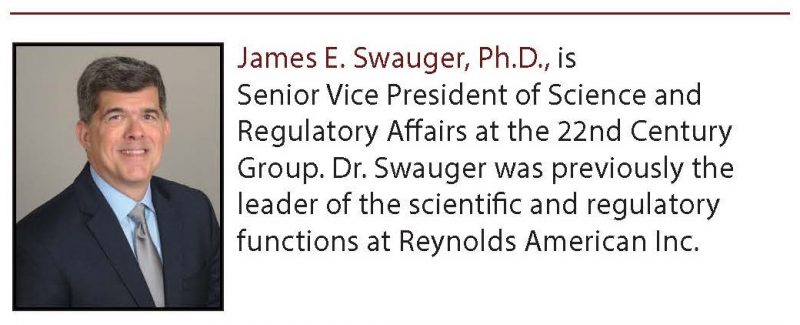Spotlight on Tobacco: FDA Plan for Tobacco and Nicotine Regulation
by James E. Swauger
Historically, tobacco harm reduction initiatives have focused on efforts to prevent or reduce tobacco initiation rates, increase quit rates, and decrease recidivism. In an unexpected and gutsy move last July, FDA Commissioner Scott Gottlieb, M.D., announced FDA’s intention to limit nicotine in cigarettes to “minimally or non-addictive levels.” In his announcement, Dr. Gottlieb explained that it has long been known that nicotine is the primary addictive component of cigarettes and that, if smokers lose their addiction to cigarettes, they will be free to choose when and how often to smoke.
A key component in FDA’s announced plan is to provide smokers with other, less harmful means to obtain nicotine. In other words, to provide a migration route away from traditional cigarettes to other types of tobacco or nicotine products such as cigarettes based on heat not burn technology, traditional smokeless products, snus, or electronic nicotine delivery systems (ENDS). Pragmatically, facilitating the migration of cigarette smokers to other forms of tobacco or nicotine will require policies and regulations that promote products that are acceptable to smokers.
The policy decision to limit nicotine in cigarettes to minimally or non-addictive levels has the support of many in the public health community. Almost two years before the FDA plan was released, Drs. Michael Fiore and Timothy Baker wrote in the October 2015 edition of The New England Journal of Medicine: “Reducing the nicotine content of combustible tobacco to levels that will not sustain dependence seems to us to be the most promising regulatory policy option for preventing [at least] 20 million premature deaths.”1 More recently, supporting FDA’s plan to limit nicotine in cigarettes to minimally or non-addictive levels, Stanford professor, Robert N. Proctor, Ph.D. explained: “Smokers would be able to start or quit at will, without suffering the robbery of choice that defines addiction.”2
While the plan will no doubt be a lightning rod for debate in the near term, the science behind FDA’s nicotine reduction plan is sound. Very Low Nicotine Content (VLNC) cigarettes have been well-studied by a diverse group of scientists. The National Institutes of Health and other agencies of the U.S. federal government have funded numerous independent clinical trials employing VLNC cigarettes. The reported results, almost universally, demonstrate that smokers switching to VLNC cigarettes experience a reduction in cravings for cigarettes, reduce their consumption of cigarettes, and increase the frequency of quit attempts.3
Cooperation is Needed
Having spent the last two decades in the middle of the scientific and policy dialogues regarding tobacco use, associated health-related issues, and tobacco harm reduction, I am cautiously optimistic that constructive policy change in this arena is now possible. Optimistic; because FDA’s proposed comprehensive policy on tobacco and nicotine represents a bold first step away from inflexible “abstinence only” initiatives toward a more pragmatic “harm reduction” policy that promises to open a genuine dialogue on real issues. Cautiously so; because over time, the two primary stakeholders, industry and the tobacco control community, have at best spoken at or past each other, making “dialogue” a charitable descriptor for these exchanges. FDA, by formally recognizing that nicotine “is delivered through products on a continuum of risk” has provided common ground that both sides can stand upon to begin civil, truly productive conversations.
Areas of Agreement
Regardless of affiliation, most professionals with an interest in the field can likely agree that reducing disease and death associated with cigarette smoking is in the best interest of not only tobacco consumers, but society as well. Further, most would also agree that the best way for smokers to achieve these risk reductions is to quit.
There is also agreement, at least conceptually, that smokers who do not want to quit tobacco altogether should consider switching to tobacco products that may present less risk to their health. Over time, a strong public health consensus has formed that not all tobacco products present the same risk. Many public health authorities agree that there is a broad continuum of risk among tobacco products, with conventional, combustible cigarettes at the highest risk end of that spectrum. This perspective is shared by the largest tobacco companies operating in the U.S. market.’’4,5,6 Over time these companies have diversified into multiple tobacco product sectors and operate businesses that market among other tobacco products, traditional smokeless products, snus, and ENDS in addition to traditional cigarettes. These companies have been vocal about the need and responsibility we have to communicate what we know about the relative risks of various tobacco products and the fundamental obligation we all share to allow the consumer to make informed choices. On January 1, 2018, Phillip Morris International announced the company’s ambition to “stop selling cigarettes in the UK” identifying e-cigarettes and heated tobacco products as “better options” for smokers.7 The stars must be aligned because it would appear that for once industry, public health, and FDA may be on the same page.
What Does the Public Think?
On March 16, 2018 FDA issued an advance notice of proposed rulemaking (ANPRM) to obtain information for consideration in establishing a maximum nicotine level for cigarettes. The notice, which marks the first official step in the regulatory process will be open for public comment until June 14, 2018. There is little doubt that public health organizations and industry will actively participate in the regulatory process. However, the largest stakeholder, comprised of both smokers and non-smokers alike, is simply the American public. Three survey-based research articles published in 2018 have revealed broad public support for reducing nicotine in cigarettes. The first, using data collected between September 2014 and May 2015, found that a majority of respondents (71%) thought FDA “should reduce nicotine in cigarettes.”8 Another article, using data from the “2016 International 4 Country Tobacco and E-Cigarette Survey” reported that 63% of smokers would “support a law that reduced the amount of nicotine in cigarettes and tobacco.”9 And a survey conducted in May 2017 found that 68% of adults in the U.S. agreed that “government should mandate that all cigarettes have very low, non-addictive levels of nicotine.”10
And while survey data shows clear public support in the U.S. for reducing nicotine in cigarettes, similar survey-based research reveals troubling misperceptions about the role nicotine plays in the harm caused by smoking. A study published in March 2017 reported that while 83% of adults correctly believe that nicotine is the main substance in cigarettes that makes people smoke, nearly half (49%) incorrectly believed that nicotine is the main substance in cigarettes that causes cancer.11
Dissension in the Ranks
It is likely that detractors of FDA’s proposed policy will rise from both the public health community and from industry. Some in public health, while willing to support the general concept of reducing nicotine in cigarettes will no doubt cringe at any intent to facilitate the migration of smokers to potentially less risky tobacco or nicotine products. Others in public health, will struggle with any policy that facilitates the potential long term recreational use of nicotine regardless of the risk potential associated with the products. Some may withhold support out of the fear associated with the prospect of making decisions in the absence of perfect information. For example, some stakeholders will have difficulty making a judgment call—in real time—that traditional smokeless tobacco products or ENDS are less risky than cigarettes (based on something less than decades of epidemiological investigation) and advocating that current smokers switch—today.
Some in industry may raise concerns related to what they might characterize as “prohibition,” the potential reduction of nicotine to levels that while not zero, are not physiologically meaningful. Others in industry may look to extend the timeline associated with any proposed standard. Obviously, a thirty-year transition is likely more palatable to some than a three-year transition. The collective impact of these arguments, well intended or not, will be the likely delay of the implementation of any product standard addressing the reduction of nicotine in cigarettes in the U.S. That would be an unfortunate outcome given that there is no disagreement in the broader community that it is the conventional cigarette, and the risks presented by that form of tobacco product that needs to be addressed.
So Here We Are
The U.S. Centers for Disease Control and Prevention reports that approximately 68% of current cigarette smokers claim a desire to quit. Stakeholders in both public health and industry agree that the best way for smokers to reduce their risk is to quit. Given the scientific consensus regarding the risks associated with smoking conventional cigarettes, we all have an interest in helping smokers quit or migrate to products associated with less risk. FDA’s proposed policy changes appear aimed at doing just that. Vaughan Rees, Director of the Center for Global Tobacco Control at Harvard’s T.H. Chan School of Public Health offered “These twin strategies offer great promise for an end to this devastating epidemic.” Agreed. All we need now is true commitment from all the players to turn the promise into reality.
- Fiore, M., & Baker, T. (2015). Reduced-nicotine cigarettes—a promising regulatory pathway. New England Journal of Medicine, 373(14), 1289-1291.
- Proctor, R. N. (2017). FDA’s new plan to reduce the nicotine in cigarettes to sub-addictive levels could be a game-changer.
- Donny, E. C., Denlinger, R. L., Tidey, J. W., Koopmeiners, J. S., Benowitz, N. L., Vandrey, R. G., … & Drobes, D. J. (2015). Randomized trial of reduced
- nicotine standards for cigarettes. New England Journal of Medicine, 373(14), 1340-1349.
- http://www.altria.com/Responsibility/Tobacco-Harm-Reduction/Pages/default.aspx.
- http://reynoldsamerican.com/Transforming-Tobacco/Guilding-Principles-and-Beliefs/default.aspx#Harm-Reduction.
- https://www.jti.com/about-us/what-we-do/our-reduced-risk-products.
https://www.pmi.com/who-we-are/designing-a-smoke-free-future. - Schmidt, A. M., Kowitt, S. D., Myers, A. E., & Goldstein, A. O. (2018). Attitudes towards Potential New Tobacco Control Regulations among US Adults. International journal of environmental research and public health, 15(1), 72.
- Cummings, K Michael et al. Support for Policies Regulating Nicotine in Cigarettes: Findings From The ITC Four Country Tobacco and E-Cigarette Survey. SRNT, Baltimore 2018, POS1-94.
- Vail, J and Moynihan, M. Mandated Reduction of Nicotine in Cigarettes: Level of Agreement of Adults in Australia, Canada, Japan, United Kingdom and United States. SRNT, Baltimore 2018, POS1-144.
- O’Brien, E. K., Nguyen, A. B., Persoskie, A., & Hoffman, A. C. (2017). US adults’ addiction and harm beliefs about nicotine and low nicotine cigarettes. Preventive medicine, 96, 94-100.
Update Magazine
March/April 2018









